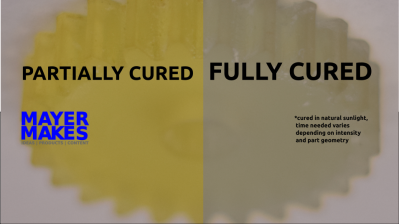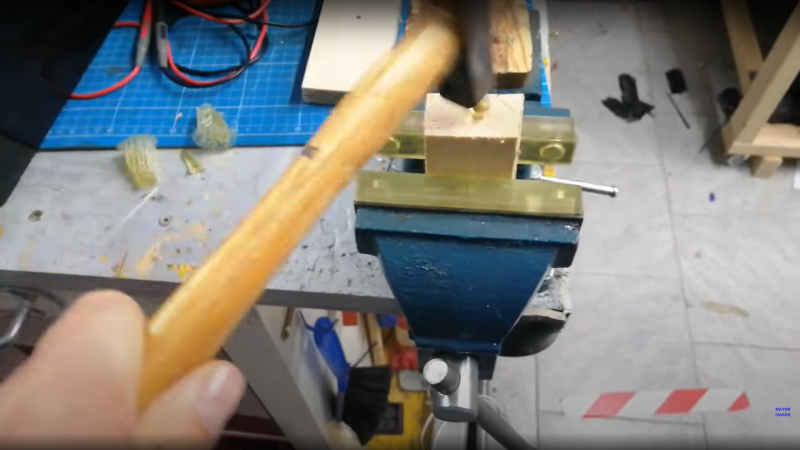Resin printing still seems to polarize opinions amongst hacker types, with some considering such machines a good tool for the right tasks, and some just plain rejecting them outright. There are many arguments for and against, but like fused deposition modeling (FDM) machines, resin printers are improving in leaps and bounds — and so is the liquid resin itself. Nowadays low-odor resins are common, colors and finishes are varied, and now thanks to some dedicated development work, the brittleness that often characterizes such prints it being addressed. [Mayer Makes] has designed a super tough “engineering resin” that he demonstrates is so tough, you can print a nail and hammer it into a block of wood! (Video, embedded below, if you don’t believe it.)
This particular resin is destined for mixing, given its natural cured shade is a kind of greenish-grey, but it does have a neat trick of presenting a definite yellowish hue when not fully cured, which is very helpful. This is particularly useful when removing support structures as you can use the color change during the curing process to judge the right moment to snap off the thicker sections, minimizing the risk of damaging the print. The resulting printed part is also tough enough to withstand subsequent traditional post-processing, such as milling, giving greater final finishing tolerances. Try doing that with an FDM print.
have a neat trick of presenting a definite yellowish hue when not fully cured, which is very helpful. This is particularly useful when removing support structures as you can use the color change during the curing process to judge the right moment to snap off the thicker sections, minimizing the risk of damaging the print. The resulting printed part is also tough enough to withstand subsequent traditional post-processing, such as milling, giving greater final finishing tolerances. Try doing that with an FDM print.
One of the neat things about resin chemistry is that you can simply mix them in their liquid form to tune the resin properties yourself and they can also be colored with specially formulated dyes without affecting the other properties too much, so this new super-tough resin gives prototypers yet another tool in their resin armory.
Thinking of taking the plunge and giving resin printing a try? Checkout our handy guide which may give you a leg up! If that doesn’t swing it for you, you could always use resin to help smooth out your FDM prints. It’ll probably still smell funny, mind.
















Still lots of questions about that resins real material properties, lots of the better resins could take being hammered into soft wood end grain with what looks like a pilot hole, just don’t wack ’em too hard as almost all (if not all) ‘high strength’ UV cured resins fail with the brittle failure method so you won’t get any warning its about to go before it does…
You certainly can machine FDM prints if you want to, but most of the time FDM prints are very hollow and in plastics that are quite elastic and will melt under the cutting tool pretty easily, however the right selection of printer settings, plastics and cutting profiles and coolant you can.
Depends a lot how you drive it too, I’ve seen a candle embedded into a door by stuffing it into a shotgun.
I thought I heard of a nailing system that used nylon in a printer/weedwhacker filament type form, for making metal free packing boxes for something. It fired them in and made a head by melting and squishing I think, long time ago I saw it and memory is less than photographic.
Very true, not really the test done here though.
Also never heard of a candle from a shotgun myself (sounds rather dangerous to the shooter as well) but the concept of relatively soft cylinder of something driven through other stuff by virtue of very high momentum is well proven and not that hard to understand though it can be hard to model mathematically.
Get it fast enough (well into the supersonic regime, ideally into the hypersonic or above) and it gets easier to model mathematically again, using Newtonian impact depth: projectile length times projectile density divided by target density equals impact depth. A paraffin wax candle (900 kg/m3) into – for example – a cedar (480 kg/m3) should embed about half the candle’s length into the wood, with sufficient velocity. Your candle is not guaranteed to survive the experience, and your door likely won’t be too happy about it either.
you can find all the Material properties in the Safety and Technical Datasheets
As well as user experiences and profiles on this github repo: https://github.com/mayermakes/Engineering-Resin
here is another Demo: https://youtu.be/pv8RbB5g9iM
Kind of the origin of this Resin was that I used to machine Normal Resin prints to the right fit .. took measuremnts and the nreprinted themin petg or ASA, so this material was menat to skip a few steps for faster prototyping. It turned out a lot better than intitially expected.
Btw. you can even cut and engrave it in a Co2-Laser but I can’t officially recommend that as I can’t afford the tests for this yet.
I looked, didn’t find numbers for toughness or fracture toughness.
Am I looking at the wrong file or taking you too literally?
IIRC there are very few things as tough as mild steel. Highly doubt this plastic is.
you find numbers in the technical datasheet https://github.com/mayermakes/Engineering-Resin/blob/main/technical%20Datasheet_%20MAYER%20MAKES_Engineering%20Resin.pdf
could not afford more lab tests yet. fracture toughness is really hard to judge since the material does not shatter like normal resins, at some point it plastically deforms, so a typical fracture test might not yield usable results.
the Charpy impact test was conducted and it yields 51,3 kJ/m2
for some other Resins you find values for this test, but its still hard to compare since they all fail quite different.
Would it make sense to add micron scale fibers to reinforce prints, similar to a traditional composite? I’m sure there’s a balancing act between adding strength and not getting in the way of the curing/printing process, but has that been explored?
I’ve seen folks add all sorts of artsy things like mica powders and glitter without really making much odds to the cure process, chopped fibers might be a tougher sell though – any that try to stick out of the surface will be problematic to details and final finish.
I’m actually working on something like this. but its a long way ahead of me.
I was hoping that this was going to be a DIY hack with chemistries involved.
I’d bet it is nowhere near that strong in tension or shear.
what kind of test would you like to see?
here is a skateboard truck printed with it for example : https://youtu.be/pv8RbB5g9iM
I’m always open to requests for testprints to show what is possible with this stuff.
the “CNC Kitchen” Youtube guy does a bunch of controlled tests – it would be fascinating to see how this stacks up.
that is correct, and I’m in contact with him.
https://www.testresources.net/applications/test-types/shear-test/
https://en.wikipedia.org/wiki/Tensile_testing
Just printing stuff and hitting it with a hammer and saying “look how strong” is apocryphal at best.
https://en.wikipedia.org/wiki/Tensile_testing
https://www.testresources.net/applications/test-types/shear-test/
Claimed results from printing something, hitting it with a hammer and saying “look how strong” are apocryphal at best.
I don’t seem to be able to post the answer I want to give. Look up “shear testing” and “tension testing”. Just printing something and hitting it with a hammer then saying “look how strong” is apocryphal at best.
my comment with the Datasheet links is also in moderation so here is the data:
Young‘s modulus ISO 527 1300 MPa
Elongation at break ISO 527
Tensile Strenght ISO 527 41,5 MPa
Charpy impact test 51,3 kJ/m2
HDT B 42 °C
Density ρ 1,18 g/cm
Shore Hardness 71D
these are standardized tests results Search “mayermakes” on github to find the repo.
That’s what I had in mind.
What about long term UV stability and water/oil absorption- would also be very good things to test if you haven’t already.
(so many decent resins seem to fall down on the last one once they get into use with wildly altered properties or warping, probably hard to really test sensibly though, the UV one is usually well defined in advance though.)
So the material actually needs alot of UV to fully cure. the built in curind indicator (yellow colorant) fades away when the material is fully cured-> becomes colorless. During the initial tests Ihad parts laying in the garden for 5 months in broad sunlightr without any signs of degradation. Currently some people who bought it are conducting experiments on usage in harsh conditions, but since the material itself is just about a year old, there has been no long time study conducted yet.
I am reliant on the community to do some of these tests to answer questions for their applications as I just cant afford more lab tests at the moment.
it is not intended for underwater usage, but a User had good results with mixing it 50/50 with a standard Resin and black dye in freshwater use.
Saltwater used is currently tested by another User, I expect similar results.
I’m very happy for every feedback/ results people report on my github as this influences further developments and the decission for specific lab tests.
I was just at a wood working and cabinet making show. There were some guys at a booth there with polymer nails that shot out of pneumatic nail guns. Their main idea was for cnc hold down because the polymer wouldn’t mess up the cutting bits on cnc machines. You can also sand over it, but they aren’t good for long term holds. Kinda the same idea here.
Nice video. I am glad to see more and more tough resins I saw an engineer made a siliencerr test with Siraya Tech Blu resin: https://www.youtube.com/watch?v=ekDs60QxmNE
How much per L in usd?
thanks for all the great feedback and the preorders! If you have specific questions, I’m today on the Makercast livestream
hosted by Bleeptrack https://www.youtube.com/watch?v=1-vu6Ve8_Nc
you can ask me there or on my socials @mayermakes on all the major plattforms.
Because of the Great Response and the influx of US Preorders we managed to figure out some stuff:
Oooh #Canada!
We have opened the @MAYERMAKES Engineering Resin pre-order to Canada!
https://mayermakes.at/2022/05/10/ooooh-canada-pre-orders-canada-have-opened/
thanks for all the support!
thanks to the tremendous support of the community we are very close to shipping!
https://mayermakes.at/2022/05/24/ready-for-shipping/
all the people who have placed a pre-order on this material will be contacted shortly!